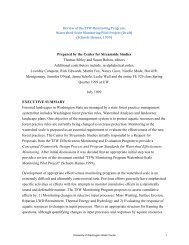Copyright 2012 Aileen M. Echiverri-Cohen - University of Washington
Copyright 2012 Aileen M. Echiverri-Cohen - University of Washington
Copyright 2012 Aileen M. Echiverri-Cohen - University of Washington
You also want an ePaper? Increase the reach of your titles
YUMPU automatically turns print PDFs into web optimized ePapers that Google loves.
<strong>Echiverri</strong>, & Grillon; 2006). Given that the mPFC is implicated in fear inhibition during<br />
treatment (Milad & Quirk, 2002) and in impaired top-down control <strong>of</strong> the amygdala (Milad et al.,<br />
2009), increased inhibitory processes may underlie treatment recovery (Rauch, Shin, Whalen, &<br />
Pitman, 1998). Accordingly, the potential effects <strong>of</strong> pharmacological agents such as selective<br />
serotonin reuptake inhibitors (SSRIs) and exposure-based psychotherapies, such as prolonged<br />
exposure, on the relationship between the mPFC and the amygdala suggest that inhibitory<br />
deficits may be normalized over the course <strong>of</strong> treatment. Therefore, inhibitory processes ought to<br />
improve following successful treatment.<br />
Generally, the preponderance <strong>of</strong> work suggests that selective serotonin reuptake<br />
inhibitors (SSRIs) are effective in treating PTSD (e.g., Brady et al., 2000; Davidson, Rothbaum,<br />
van der Kolk, Sikes, & Farfel, 2001; Davidson et al., 2003; Marshall, Beebe, Oldham, &<br />
Zaninelli, 2001; Rothbaum, Ninan, & Thomas, 1996). Of all the SSRIs, sertraline (SER) is the<br />
best studied for PTSD (Fabre et al., 1995; Davidson et al., 2003, 2001). Although there is no<br />
direct evidence <strong>of</strong> inhibitory changes, indirect evidence from animals and humans <strong>of</strong> the mPFC<br />
and amygdala after SSRI administration points to a potential link between SSRIs and enhanced<br />
inhibition. Animal studies show initial evidence <strong>of</strong> functional changes in the brain implicated in<br />
inhibition from pharmacotherapy. For instance, there is a growing body <strong>of</strong> evidence to suggest<br />
that SSRIs enhance neurotransmission <strong>of</strong> serotonin to metabolize stress hormones (e.g., Heym &<br />
Koe, 1998; Hashimoto et al., 1999; Inoue et al., 1996; Geyer et al., 1988), down-regulates<br />
noradrenergic neurotransmission (Koe, Koch, Lebel, Minor & Page, 1987), and reduces<br />
immobility or inactivity (Koe, Weissman, Welch, & Browne, 1983). There are no animal studies<br />
to date that have examined the chronic effects <strong>of</strong> SSRIs in animal models <strong>of</strong> PTSD. Still, the<br />
pattern <strong>of</strong> evidence in animal research <strong>of</strong>fers a modicum <strong>of</strong> support for improvement in<br />
11
















